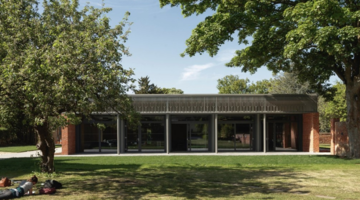Sustainability Spotlight - Deputy Head of Environmental Sustainability
Sustainability Spotlight
This new blog series ‘Sustainability Spotlight’ is intended to share more information about the various roles and projects that exist within the Sustainability team. Environmental Sustainability has such a broad scope that, although we have a Meet the team page, we want to share some more in-depth information about what sustainability means in practice.
We hope this will help to raise awareness of what is happening, foster engagement and share knowledge about work that has largely been kept under the radar!
In this Sustainability Spotlight blog we speak with Tom Heel, Deputy Head of Environmental Sustainability.
What is your job role/what do you do?
There are three main sections to my role; leading on the development and delivery of sustainable building policy on capital and R&M projects, overseeing the delivery of projects that aim to deliver carbon emissions reductions on existing buildings and managing the energy procurement, billing and management function within the team.
What has your career path been so far? How did you end up doing this job?
I have been working in the fields of social responsibility, sustainability and renewable energy for over fifteen years. I’m not sure there is a standard career path for anyone in our team or indeed in the sector and my path looks perhaps more planned with hindsight than it felt at the time. Sustainability is justifiably an area of increasingly strong growth and I have been fortunate to take some exciting opportunities that lead me to doing what I do now for the University.
What challenges do you face, in your job and in the wider industry?
I think anyone that works in the University recognises it as a complex environment and I certainly see this as the greatest challenge. The stakeholder group for any given development in the areas of work I cover can be bewilderingly large and progress can be slower than you might like as a result. That breadth of views however frequently brings extremely valuable perspectives that shape our work to the positive.
In the wider industry I think the voice of sustainability has suffered from being marginalised historically and occasionally by being greeted with apathy but it feels like this is changing very rapidly now.
What do you love about your job?
Having worked in a variety of different organisations it is a huge privilege to work on an estate as rich and varied as the University’s and also for an organisation that is so well resourced.
What current projects are you working on?
There is so much exciting work going on across my areas of responsibility at the moment that it is difficult to pick which are the most noteworthy. I think we are on the verge of some really transformative developments in the way we manage our utilities, we have buildings in design which could be of national interest in terms of their performance and we are getting closer to delivering some heat network projects which have been on the horizon for many years and which could unlock a significant decarbonisation of heat for the University in the long term.
Why are you focusing on these projects/why are they important?
The University’s carbon reduction target is really stretching, particularly as we continue to grow quite rapidly. We are trying to focus our energies on projects that deliver the greatest impact in pursuit of that target whilst ensuring the highest quality work and learning space for colleagues. We are also trying to streamline our administrative activities to enable us to focus more of our resources on reducing consumption and emissions.
What has surprised you most?
I don’t think anyone could fail to be struck with the apparent speed of change in awareness and engagement in sustainability at the moment. I look forward to seeing how this increases the impact of our work and the impact the University is able to have in this area.
What is the worst example of sustainability you have seen?
There are so many examples of good intentions that have been undermined by a lack of understanding. We also often pile in technology and complexity in pursuit of optimum performance and end up with something that is challenging to get working and impossible to control. Things are always improving but one that made me laugh out loud was a bat box installed next to a busy entrance and under a flood light.
How about the best example of sustainability you have seen?
I think seeing the enthusiasm, knowledge, intelligence and seriousness with which some students I have had the pleasure to work with approach sustainability is the best example I have seen. I don’t think I could pick a specific thing but it is clearly where the University has its greatest potential for future impact and where the greatest potential to make significant changes to the institution lies.

Kellogg Hub, picture by Tim Crocker
What has been your best experience so far?
I think the enthusiasm with which the project team grasped the challenge of delivering the University’s first Passivhaus certified building at Kellogg College was really gratifying to be part of.
What are you most looking forward to?
Given that projects can be quite long in the gestation in such a complex organisation it’s really getting to the point that some exciting things we are working on bear fruit.
Share your ideas
If you found this blog interesting or want to know more about another area of Sustainability, just let us know on social media or email sustainability@admin.ox.ac.uk.
Next steps
If you enjoyed Tom's blog, why not visit these?
More blog entries


